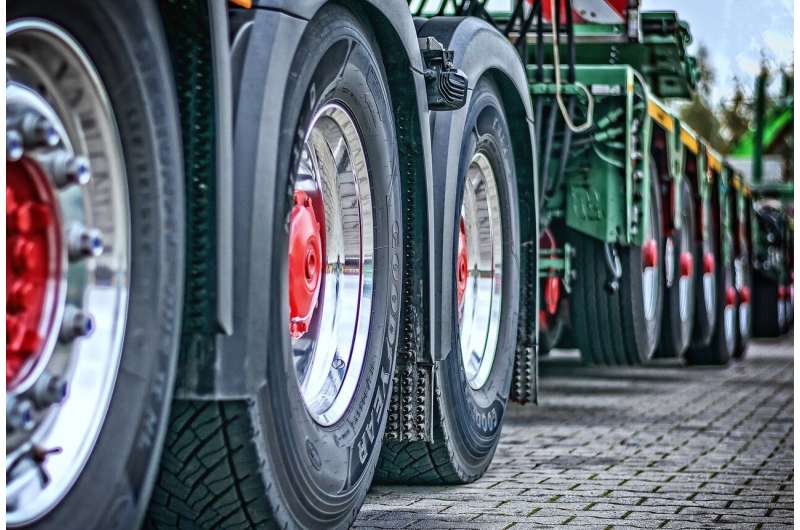by Anne-Catherine Jung, Fraunhofer-Institut für System- und Innovationsforschung (ISI)

Led by Fraunhofer ISI, the BOLD project provided scientific support accompanying three field trials and 12 other research projects on electric trucks powered by overhead lines. Together with ifeu and Öko-Institut, Fraunhofer ISI analyzed the acceptance of the technology, the opportunities and barriers in industry and the policy landscape as well as the climate and environmental impact of the technology.
The now published final report describes the main lessons from these projects and assesses the potential rollout of the technology.
The transport sector is especially challenging in terms of greenhouse gas emission reductions as demand continues to increase worldwide, especially for freight transport. Here, catenary trucks powered by overhead lines represent one promising solution because of their high efficiency, comparably low costs and positive effects for the climate if they are charged with renewable electricity.
The German government is currently conducting three field trials to test electric drive trains in heavy-duty vehicles. Fraunhofer ISI together with its partners ifeu and Öko-Institut accompanied these field trials (in the projects ELISA, FESH and eWayBW) as well as twelve other research projects on legal aspects, energy provision and market potential, and coordinated the research in the BOLD project, which brought together all in the diverse projects involved partners to discuss their joint findings.
How are overhead catenary trucks perceived by the public, manufacturers and the political landscape?
A first outcome is that stakeholders in the energy sector or haulage companies are open toward catenary electric trucks and are satisfied with the technology. This is also true for some truck manufacturers such as Scania that has a clearly positive attitude towards overhead catenary electric trucks and provided the vehicles for field trials in Sweden and Germany. Others such a Daimler Truck remain more critical while the majority of truck providers is indifferent.
The project also revealed a lack of public understanding and misleading comparisons regarding the costs and actual technological readiness of the various alternative drive options. Local residents and local political actors were the most critical here. It also became clear that the main manufacturers are now concentrating on battery electric trucks and stationary charging and that the potential implementation and resilience of the catenary system depend on only a few manufacturers while fuel-cell electric trucks remain an option for a few manufacturers, but without pursuing it at the highest priority.
Concerning the political landscape, an actor network analysis revealed that many international actors are waiting for the German government’s decision, and that the country is perceived as a key player to which other countries look for orientation. Sweden and France are also important but play a subordinate role due to their geographical location (Sweden) or their focus on electric rails (France). Austria, Denmark, Great Britain, Italy, and the Netherlands perceive barriers to the technology if key countries like Germany do not make a clear political commitment to it. At EU level, interviews show that Electric Road Systems in general have not played a main role in policy discussions.
Many EU policymakers remain uninformed or indifferent to the technology, and national policymakers have not explicitly lobbied for the technology.
What climate and environmental impacts do catenary trucks have?
Other findings concern the climate balance of overhead catenary trucks compared to alternatives such as Battery Electric Trucks (BETs), Fuel Cell Electric Trucks (FCETs) and the use of Power-to-Liquid (PtL) fuels, and what overall environmental impacts these technologies have—both aspects were included in the BOLD project. The comparative life cycle assessment of each technology revealed that the direct use of electricity, whether to charge batteries or overhead power lines, is a technically feasible alternative for large shares of road freight and has a positive climate balance even in the short term.
Here, overhead catenary trucks with smaller batteries have an advantage over BETs: The results show not only slightly higher greenhouse gas savings, but also a significant reduction in other environmental impacts such as acidification and eutrophication compared to BETs.
What would be the next steps for a rollout of catenary trucks?
Dr. Till Gnann, who coordinated the research activities in the BOLD project at Fraunhofer ISI, summarizes the main findings. “In the BOLD project, it became clear that constructing an overhead catenary infrastructure for Germany’s highway network for long-distance road freight traffic is technically possible. The question is rather which technology will prevail in the end, how long its infrastructure construction will take and how long it can be subsidized due to underutilization.
“If the overhead catenary system and its market ramp-up are to succeed, the technology in terms of vehicles and infrastructure must be further developed and a market for catenary vehicles must be created. For this to happen requires a clear signal and decision in the near future for the use of catenary electric trucks by the German federal government. This would provide clarity for industry, research, and neighboring countries.”
Provided by
Fraunhofer-Institut für System- und Innovationsforschung (ISI)
Citation:
Overhead catenary e-trucks: Lessons for the future of the technology (2023, October 30)
retrieved 30 October 2023
from https://techxplore.com/news/2023-10-overhead-catenary-e-trucks-lessons-future.html
This document is subject to copyright. Apart from any fair dealing for the purpose of private study or research, no
part may be reproduced without the written permission. The content is provided for information purposes only.
